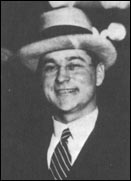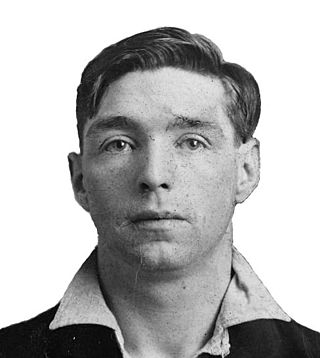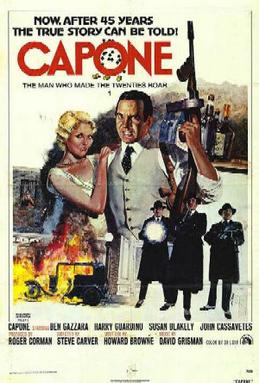
John Donato Torrio was an Italian-born American mobster who helped build the Chicago Outfit in the 1920s later inherited by his protégé Al Capone. Torrio proposed a National Crime Syndicate in the 1930s and later became an adviser to Lucky Luciano and his Luciano crime family.

Frank Ralph Nitto, known as Frank Nitti, was an Italian-American organized crime figure based in Chicago. The first cousin and bodyguard of Al Capone, Nitti was in charge of all money flowing through the operation. Nitti later succeeded Capone as acting boss of the Chicago Outfit.

Louis "Two Gun" Alterie, born Leland A. Varain, and aka "Diamond Jack Alterie", was a Californian who became a notorious hitman for the Chicago North Side Gang during the early years of Prohibition.
The Valley Gang was an Irish-American street gang in Chicago, Illinois during the early 20th century, which ultimately made the transition to organized crime and became a de facto extension of the Chicago Outfit under Al Capone.

Owen Vincent "Owney" Madden was an English-born gangster of Irish ancestry who became a leading underworld figure in New York during Prohibition. Nicknamed "The Killer", he garnered a brutal reputation within street gangs and organized crime. He ran the Cotton Club in Manhattan and was a leading boxing promoter. After increased attention from law enforcement in New York, Madden moved to Hot Springs, Arkansas, in 1935, where he remained until his death from natural causes in 1965.
The Genna crime family, was a crime family that operated in Prohibition-era Chicago. From 1921 to 1925, the family was headed by the six Genna brothers, known as the Terrible Gennas. The brothers were Sicilians from the town of Marsala and operated from Chicago's Little Italy and maintained control over the Unione Siciliana. They were allies with fellow Italian gang the Chicago Outfit. After a bloody war led to their demise in the 1920s, the gang was eventually absorbed by the Chicago Outfit.
The North Side Gang, also known as the North Side Mob, was an Irish-Polish-American criminal organization within Chicago during the Prohibition era from the early 1920s to the mid-1930s. It was the principal rival of the South Side Gang, also known as the Chicago Outfit, the crime syndicate of Italian-Americans Johnny Torrio and Al Capone.

The Atlantic City Conference held between 13–16 May 1929 was a historic summit of leaders of organized crime in the United States. It is considered by most crime historians to be the earliest organized crime summit held in the US. The conference had a major impact on the future direction of the criminal underworld and it held more importance and significance than the Havana Conference of 1946 and the Apalachin meeting of 1957. It also represented the first concrete move toward a National Crime Syndicate.
Salvatore V. "Sam" Maceo was an American business entrepreneur, power broker and racketeer in Galveston, Texas, who controlled both the government and organized crime in the city for almost 30 years. During the 1920s and 1930s, Galveston emerged as a nationally known resort city, because of the gambling, prostitution and free flowing liquor, vices that were offered at the backrooms of restaurants and nightclubs, a period known as Galveston's Open Era. His organization, often called the Maceo Syndicate or the Maceo Organisation, was involved in illegal gambling, prostitution, numbers racket and bootlegging and he received substantial income from these activities.

Capone is a 1975 American biographical crime film directed by Steve Carver, written by Howard Browne, and starring Ben Gazzara, Harry Guardino, Susan Blakely, John Cassavetes, and Sylvester Stallone in an early film appearance. The film is a biography of the infamous gangster Al Capone.

The Free State of Galveston was a satirical name given to the coastal city of Galveston in the U.S. state of Texas during the early-to-mid-20th century. Today, the term is sometimes used to describe the culture and history of that era.
Rosario Maceo (Sr.), also known as Papa Rose or Rose Maceo, was an Italian-American businessman, power broker and crime boss in Galveston, Texas in the United States. Because of his efforts and those of his brother Sam, Galveston Island became a nationally known resort city during the early and mid 20th century, during a period known as Galveston's Wide-Open Era. They owned various restaurant and casino venues including the now-vanished Hollywood Dinner Club and the Balinese Room. He became an Al Capone-like figure in the city. Sometimes known as the "Iron Glove", Rose was the top enforcer for the empire he and his brother formed.

Johnny Jack Nounes, also known as the "Beau Brummell of Galveston", was a mob boss in Galveston, Texas, United States, during the 1920s and 1930s. He, with one-armed George Musey, led the Downtown Gang, one of the two gangs which controlled most of the Galveston Crime Syndicate until the early 1930s. They fought for control of the island against the rival Beach Gang led by Ollie Quinn and Dutch Voight, and later their successors, the Maceo Crime Syndicate. As the prohibition era began, his gang came to be one of the dominant forces in the Galveston Crime Syndicate. Galveston became the main port of entry for liquor supply in Texas and many parts of the Midwest. Nounes' flamboyance attracted the attention of federal authorities, leading to his conviction in 1924 and sentencing to Leavenworth Penitentiary. His prison term was short but only two years after being released he was again sentenced to prison after being caught with a shipment of liquor in Seabrook. Frank Nitti, a business partner of Nounes, was the "enforcer" for Al Capone's crime organization in Chicago as well as the future boss of the Chicago Outfit.
Ollie Johnson Quinn was a mob boss in Galveston, Texas in the United States, who was involved in bootlegging, illegal gambling, numbers racket, prostitution and other criminal activities from the 1910s up until the 1930s. He, with Dutch Voigt, led the Beach Gang, one of the two criminal organisations which controlled most of the Galveston underworld until the mid-1920s.
Oscar Ernest "Dutch" Voigt was an American mob boss in Galveston, Texas in the United States, who was involved in bootlegging, illegal gambling, numbers racket, prostitution and other criminal activities during the early 1900s. Voight was called Dutch for Deutsch meaning German. He, with Ollie Quinn, led the Beach Gang, one of the two criminal organisations which controlled most of the Galveston underworld until the mid-1920s. He was of German descent.
Michele "Mike the Devil" Genna was an Italian-born mobster in Chicago during the 1920s. He headed the Genna crime family with his brothers. He was killed by police officers after a shootout with North Siders, being one of the only American organized crime leaders to be killed by a policeman.
George Musey, also known as "one-armed George Musey", was a mob boss in Galveston, Texas, during the Prohibition era. Along with Johnny Jack Nounes, he led the Downtown Gang, one of two gangs which controlled the Galveston underworld until the early 1930s. He was convicted on conspiracy liquor charges in 1929 and sent to Atlanta Penitentiary. Musey was shot and killed in 1935, eight days after his 35th birthday.
The Maceo Organization, also known as the Maceo Syndicate, was a criminal organization, that ran Galveston, Texas politically and criminally throughout most of Galveston's open era. The organization's bosses, Sam and Rosario Maceo, operated illegal gambling, prostitution, bootlegging and racketeering activities.
Organized crime in the 1920s.







